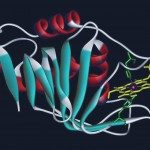Lien vers Pubmed [PMID] – 15366939
Biochemistry 2004 Sep;43(35):11295-301
The backbone hydrogen bond (H-bond) network of the partially folded A-state of ubiquitin (60% methanol, 40% water, pH 2) has been characterized quantitatively by (h3)J(NC)(‘) H-bond scalar couplings between the (15)N nuclei of amino acid H-bond donors and the (13)C carbonyl nuclei of the acceptors. Results on (h3)J(NC)(‘) couplings and the amide proton ((1)H(N)) chemical shifts for the A-state are compared quantitatively to the native state. The (h3)J(NC)(‘) correlations of the A-state show intact, nativelike H-bonds of the first beta-hairpin beta1/beta2 and the alpha-helix, albeit at lower strength, whereas the H-bonds in the C-terminal part change from a pure beta-structure to an all alpha-helical H(N)(i)–>O(i-4) connectivity pattern. A residue-specific analysis reveals that the conformations within the conserved secondary structure segments are much more homogeneous in the A-state than in the native state. Thus, the strong asymmetry of (h3)J(NC)(‘) couplings and (1)H(N) chemical shifts between the interior and exterior sides of the native state alpha-helix vanishes in the A-state. This indicates that the bend of this helix around the native state hydrophobic core is released in the homogeneous solvent environment of the A-state. Similarly, an irregularity in the behavior of H-bond I3–>L15 in hairpin beta1/beta2, which results from strong contacts to strand beta5 in the native state, is absent in the A-state. These findings rationalize the behavior of the (1)H(N) chemical shifts in both states and indicate that the A-state is in many aspects similar to the onset of thermal denaturation of the native state.

